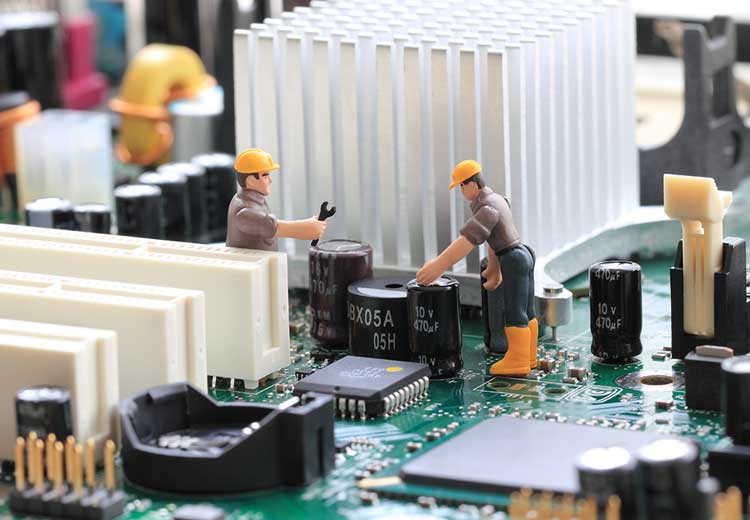How to Fix Common Computer Problems
Last updated May 2025

Don’t pay a repair shop’s minimum charge, possibly $75 or more, only to discover that the problem had a quick fix.
Do No Further Harm
If you’ve spilled liquid on your device or hear strange grinding, clicking, or other noises coming from a mechanical drive, turn it off and get thee to a professional. It might be a drive failure or cooling fans might not be working, and continued use could make it worse or result in data loss.
If you haven’t done a backup and your precious files disappear, don’t panic. Many computer repair shops offer data recovery services; you can DIY by using online services such as Stellar or GetDataBack. These will scan your drive and indicate whether files can be recovered; if they can, you then pay $70 to $100 to have them do so.
Sometimes, Solutions Are Simple
Before schlepping your device to a shop, an Apple Genius Bar, or wherever, pretend someone from your office’s IT department is hovering beside you. What simple questions would they ask?
- If it’s a laptop or tablet, is it charging? If not, try switching power adapters before assuming the device itself is down.
- Trace power cords to see if they are all plugged in to an outlet (hopefully, you’re using one with a surge suppressor) and to the device.
- Check that all components are turned on and your surge suppressor is switched on.
- Experiencing slow internet speeds? Determine if your wireless router or modem is working by switching your device’s internet signal to your cellphone’s signal.
- Websites like Speedtest.net can help you figure out whether your internet service provider is the source of slow speeds.
- If you’re fighting with a printer, look to see if its ink or toner supply is inserted properly, that all printer settings are correct, and that paper is properly inserted.
- Restart and see if the problem persists. If the device is frozen, do a forced restart.
- Check storage space. If your device is full or nearly so, deleting files you don’t need should improve performance.
Beyond basic checks, you can make many internal repairs to desktops and some laptops. Seek out how-to videos online that will walk you through repairs and upgrades. If your device is still under warranty, make sure such be-your-own-help-desk attempts won’t void it—some warranties immediately cancel if you open the case.
It’s Probably the Software
Software (the programs and apps you use on your computer) can either misbehave on its own or find something about your computer’s setup that prevents it from operating properly. Software can have millions of lines of computer code and can interact differently with various devices. Unfortunately, there’s often no single answer—or source for the answer—when something goes wrong. But you probably can use a combination of resources to try to get things back under control.
Start over. Often the best software solution is simply to quit and restart the device.
Keep up to date. Make sure your device is running the most up-to-date version of its operating system and other installed software. Nearly every day, security patches are issued by device manufacturers and software companies. Failing to install updates doesn’t just make your device vulnerable to hackers, it might also create conflicts between your operating system and various software and apps. Turn on auto-update options to keep your operating system, device drivers, and all other software current.
Avoid using unsupported old operating systems (Windows 8 and older versions, for example, no longer get security patches from Microsoft, which has also said it will stop supporting Windows 10 in October 2025).
Check help files and the software manufacturer’s website. Detailed troubleshooting information can be found under the “Help” menus built into software programs (possibly useless if you can’t get the program to run) and via manufacturers’ websites.
In addition to software updates and patches, most manufacturers maintain databases of errors, problems, and solutions in the “Support” areas of their websites. Some sites, such as Microsoft Support and Apple Support, are enormous. Most will allow you to search based on keywords or error messages.
Search for solutions. Figuring out where to start is often half the work. Search for solutions to your problem posted on Reddit, manufacturers’ websites, troubleshooting guides, and so on. By choosing your search terms carefully, you can often quickly locate at least a starting point for dealing with your issue.
Devoted users of many popular programs spend hours documenting, and even fixing, many software problems. You can find their expertise on Reddit and other message boards; some manufacturers’ websites link to the latter. You can post a description of your problem and request advice; help could range from simple commiseration to a guru who has mastered your specific problem. When posting a problem, include specifics on your device and the version numbers of your operating system and afflicted software.
Reinstall software. Sometimes a key file becomes corrupted. Reinstalling the software might fix the glitch.
For Windows users, search for “Add or Remove Programs.” Then select the program you wish to remove, and then “Uninstall.” Mac users can uninstall a program by selecting the little “X” that appears when they click-hold its app-launching icon.
After that, reinstall your software—but first, read some fine print: Most software details minimum system requirements for successful operation. These requirements are truly minimums, and in most cases you will want computer resources to exceed them. Is your computer powerful enough? Do you have enough memory? Do you have a graphics processor that can keep up? Do you have more than the minimum amount of available hard-drive space? Noncompliance can cause malfunctions.
Go back in time. You might be able to force your computer to revert to a time when you are confident it was operating properly. In Windows, search for the “System Restore” function; for Macs, look for “Restore from Time Machine Backup.” Pick a restore date predating your problem.
If the problem seems to have been caused by the installation of new software, updates, or drivers, this may be a quick fix. But before attempting this, back up any important files to an external backup drive or a cloud-based backup service. When you revert to a restore point, the computer is supposed to make changes only to software or system states, but it’s always better to be safe than sorry.
Use diagnostic software. Many programs on the market can help you minimize computer difficulties. For example, Windows’ Advanced Uninstaller PRO uninstalls programs more thoroughly than Microsoft’s basic tool; searches for driver updates; and cleans up duplicate files, unneeded files, and aberrant registry entries. AVG and Norton can improve hardware performance and offer assistance on some software difficulties. Apple offers the First Aid feature of its Disk Utility. These tools can solve some software problems and minimize crashes, under certain conditions.
Clean up your hard drive. Hard-drive housekeeping can help your system run better.
Start by uninstalling unused applications. Software is a storage-space hog, and many manufacturers load up devices with dozens of preinstalled programs. But before uninstalling an app you don’t recognize, do a quick internet search to make sure it’s not something you need.
In Windows, you can run Microsoft’s disk-checking utility to make sure your hard drive is undamaged. Open “File Explorer” and double-click on “This PC” in the far-left window. Then right-click on the hard drive (usually labeled “C:\”) and then select “Properties.” Select the tools tab and then click “Check” to run diagnostics. You can also select “Optimize” to perform a disk cleanup that will improve data organization.
Mac users don’t have to worry about defragmentation issues, but they can run Apple’s “Optimize Storage” tool to solve some hard-drive problems.
Meet with your maker. Sometimes calling or initiating a chat session with the manufacturer’s tech support can resolve a problem. If your product doesn’t come with free support, however, it can cost you—some software companies charge $200 or more per session.
Whatever the price, be prepared for long wait times. If you have already tried many of the steps described above, save valuable help-session time by immediately informing the technical advisor that you already did the basics—rebooted, checked for patches and updates, reinstalled the software, etc.
Bug your friends. Luckily, many computer-savvy people live in this area (including, probably, the 15-year-old kid next door). You may be able to get help from tech-genius friends and neighbors.

Computer Care Guide
You’ll extend the lifespan of your tech by practicing good computing habits.
Safety first. If you’re not an IT professional, you’ll probably be shocked to know how often thieves and other intruders probe your devices for vulnerabilities. Click here for steps to protect against intrusions, which often cause great damage.
Exercise it early. Test any new device right away. Although you won’t necessarily avoid repairs, you’ll avoid paying for them by identifying problems while the manufacturer’s warranty or the store’s return policy remains in effect.
Avoid sharp electric power fluctuations. Sudden fluctuations in voltage can damage chips or cause data errors. Power fluctuations can come from power company activities, lightning, or downed power lines, and also when you switch on and off machines with electric motors (power tools, vacuums, other small appliances). You can minimize the danger of power fluctuations by plugging devices into surge protectors, and then plugging protectors into outlets that don’t share circuits with any electric motors.
Watch out for static. Walking across a rug on a dry day and touching a doorknob can produce unpleasant sparks. That same spark applied to computer components or data storage media can be destructive—ruining data or permanently damaging delicate circuits by hitting them with a charge of thousands of volts of electricity. If you need to remove the casing on your computer to install hardware, be careful not to discharge any static electricity directly into your computer. Touch a metal object before touching the device.
Stay cool. Heat can cause temporary malfunctions and even permanent damage. Don’t expose computer devices to prolonged direct sunlight or heat, and be sure there is room for ventilation around them.
Keep it clean. A heavy accumulation of dust can contribute to your computer overheating. Use a can of compressed air to dislodge stubborn dust deposits and a handheld vacuum cleaner with a small nozzle to clean keyboards.


